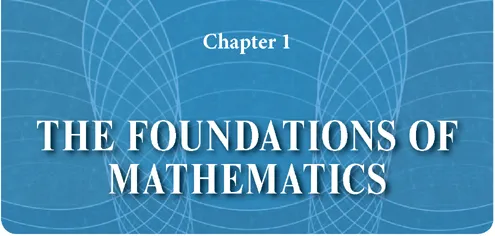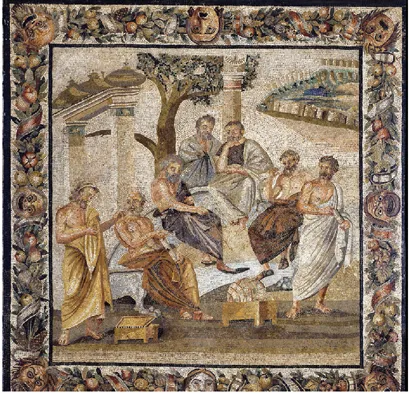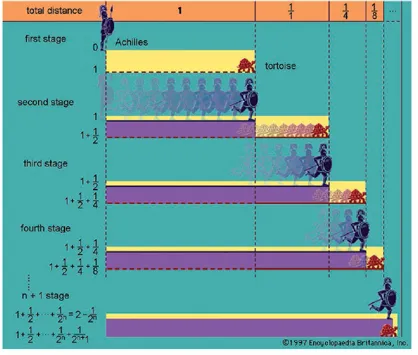
eBook - ePub
The History of Mathematics
Britannica Educational Publishing, Nicholas Faulkner
This is a test
Partager le livre
- English
- ePUB (adapté aux mobiles)
- Disponible sur iOS et Android
eBook - ePub
The History of Mathematics
Britannica Educational Publishing, Nicholas Faulkner
Détails du livre
Aperçu du livre
Table des matières
Citations
À propos de ce livre
This intriguing volume introduces readers to the origins of the mathematical principles they study every day. It covers a wide range of disciplines outlined in curriculum standards and serves as an illuminating companion to their current studies. Readers will learn about the brilliant minds behind some of the breakthroughs in mathematics. They will also enjoy the origin stories of the different disciplines in the field we're so familiar with today. The study of math should go beyond numbers, and this book certainly accomplishes that by giving readers insight into how mathematics came to be.
Foire aux questions
Comment puis-je résilier mon abonnement ?
Il vous suffit de vous rendre dans la section compte dans paramètres et de cliquer sur « Résilier l’abonnement ». C’est aussi simple que cela ! Une fois que vous aurez résilié votre abonnement, il restera actif pour le reste de la période pour laquelle vous avez payé. Découvrez-en plus ici.
Puis-je / comment puis-je télécharger des livres ?
Pour le moment, tous nos livres en format ePub adaptés aux mobiles peuvent être téléchargés via l’application. La plupart de nos PDF sont également disponibles en téléchargement et les autres seront téléchargeables très prochainement. Découvrez-en plus ici.
Quelle est la différence entre les formules tarifaires ?
Les deux abonnements vous donnent un accès complet à la bibliothèque et à toutes les fonctionnalités de Perlego. Les seules différences sont les tarifs ainsi que la période d’abonnement : avec l’abonnement annuel, vous économiserez environ 30 % par rapport à 12 mois d’abonnement mensuel.
Qu’est-ce que Perlego ?
Nous sommes un service d’abonnement à des ouvrages universitaires en ligne, où vous pouvez accéder à toute une bibliothèque pour un prix inférieur à celui d’un seul livre par mois. Avec plus d’un million de livres sur plus de 1 000 sujets, nous avons ce qu’il vous faut ! Découvrez-en plus ici.
Prenez-vous en charge la synthèse vocale ?
Recherchez le symbole Écouter sur votre prochain livre pour voir si vous pouvez l’écouter. L’outil Écouter lit le texte à haute voix pour vous, en surlignant le passage qui est en cours de lecture. Vous pouvez le mettre sur pause, l’accélérer ou le ralentir. Découvrez-en plus ici.
Est-ce que The History of Mathematics est un PDF/ePUB en ligne ?
Oui, vous pouvez accéder à The History of Mathematics par Britannica Educational Publishing, Nicholas Faulkner en format PDF et/ou ePUB. Nous disposons de plus d’un million d’ouvrages à découvrir dans notre catalogue.
Informations
Année
2017ISBN
9781538300411

Mathematicians have long studied the logical and philosophical basis of mathematics, including whether the axioms of a given system ensure its completeness and its consistency. Because mathematics has served as a model for rational inquiry in the West and is used extensively in the sciences, foundational studies have far-reaching consequences for the reliability and extensibility of rational thought itself.
A remarkable amount of practical mathematics, some of it even fairly sophisticated, was already developed as early as 2000 BCE by the agricultural civilizations of Egypt and Mesopotamia and perhaps even farther east. However, the first to exhibit an interest in the foundations of mathematics were the ancient Greeks.
Arithmetic or Geometry
Early Greek philosophy was dominated by a dispute as to which is more basic, arithmetic or geometry, and thus whether mathematics should be concerned primarily with the (positive) integers or the (positive) reals, the latter then being conceived as ratios of geometric quantities. (The Greeks confined themselves to positive numbers, as negative numbers were introduced only much later in India by Brahmagupta.) Underlying this dispute was a perceived basic dichotomy, not confined to mathematics but pervading all nature: is the universe made up of discrete atoms (as the philosopher Democritus believed) which hence can be counted, or does it consist of one or more continuous substances (as Thales of Miletus is reputed to have believed) and thus can only be measured? This dichotomy was presumably inspired by a linguistic distinction, analogous to that between English count nouns, such as “apple,” and mass nouns, such as “water.” As Aristotle later pointed out, in an effort to mediate between these divergent positions, water can be measured by counting cups.
The Pythagorean school of mathematics, founded on the doctrines of the Greek philosopher Pythagoras, originally insisted that only natural and rational numbers exist. Its members only reluctantly accepted the discovery that √2, the ratio of the diagonal of a square to its side, could not be expressed as the ratio of whole numbers. The remarkable proof of this fact has been preserved by Aristotle.
The contradiction between rationals and reals was finally resolved by Eudoxus of Cnidus, a disciple of Plato, who pointed out that two ratios of geometric quantities are equal if and only if they partition the set of (positive) rationals in the same way, thus anticipating the German mathematician Richard Dedekind (1831–1916), who defined real numbers as such partitions.

Mosaic floor depicting Plato (sitting, middle) teaching a group of disciples of the Academy of Athens
Being Versus Becoming
Another dispute among pre-Socratic philosophers was more concerned with the physical world. Parmenides claimed that in the real world there is no such thing as change and that the flow of time is an illusion, a view with parallels in the Einstein-Minkowski four-dimensional space-time model of the universe. Heracleitus, on the other hand, asserted that change is all-pervasive and is reputed to have said that one cannot step into the same river twice.
Zeno of Elea, a follower of Parmenides, claimed that change is actually impossible and produced four paradoxes to show this. The most famous of these describes a race between Achilles and a tortoise. Since Achilles can run much faster than the tortoise, let us say twice as fast, the latter is allowed a head start of one mile. When Achilles has run one mile, the tortoise will have run half as far again—that is, half a mile. When Achilles has covered that additional half-mile, the tortoise will have run a further quarter-mile. After n + 1 stages, Achilles has run

miles and the tortoise has run

miles, being still 1/2n + 1 miles ahead. So how can Achilles ever catch up with the tortoise?
Zeno’s paradoxes may also be interpreted as showing that space and time are not made up of discrete atoms but are substances which are infinitely divisible. Mathematically speaking, his argument involves the sum of the infinite geometric progression

no finite partial sum of which adds up to 2. As Aristotle would later say, this progression is only potentially infinite. It is now understood that Zeno was trying to come to grips with the notion of limit, which was not formally explained until the 19th century, although a start in that direction had been made by the French encyclopaedist Jean Le Rond d’Alembert (1717–83).

Zeno's paradox, illustrated by Achilles racing a tortoise
Universals
The Athenian philosopher Plato believed that mathematical entities are not just human inventions but have a real existence. For instance, according to Plato, the number 2 is an ideal object. This is sometimes called an “idea,” from the Greek eide, or “universal,” from the Latin universalis, meaning “that which pertains to all.” But Plato did not have in mind a “mental image,” as “idea” is usually used. The number 2 is to be distinguished from a collection of two stones or two apples or, for that matter, two platinum balls in Paris.
What, then, are these Platonic ideas? Already in ancient Alexandria some people speculated that they are words. This is why the Greek word logos, originally meaning “word,” later acquired a theological meaning as denoting the ultimate reality behind the “thing.” An intense debate occurred in the Middle Ages over the ontological status of universals. Three dominant views prevailed: realism, from the Latin res (“thing”), which asserts that universals have an extra-mental reality—that is, they exist independently of perception; conceptualism, which asserts that universals exist as entities within the mind but have no extra-mental existence; and nominalism, from the Latin nomen (“name”), which asserts that universals exist neither in the mind nor in the extra-mental realm but are merely names that refer to collections of individual objects.
It would seem that Plato believed in a notion of truth independent of the human mind. In the Meno Plato’s teacher Socrates asserts that it is possible to come to know this truth by a process akin to memory retrieval. Thus, by clever questioning, Socrates managed to bring an uneducated person to “remember,” or rather to reconstruct, the proof of a mathematical theorem.
The Axiomatic Method
Perhaps the most important contribution to the foundations of mathematics made by the ancient Greeks was the axiomatic method and the notion of proof. This was insisted upon in Plato’s Academy and reached its high point in Alexandria about 300 BCE with Euclid’s Elements. This notion survives today, except for some cosmetic changes.
The idea is this: there are a number of basic mathematical truths, called axioms or postulates, from which other true statements may be derived in a finite number of steps. It may take considerable ingenuity to discover a proof; but it is now held that it must be possible to check mechanically, step by step, whether a purported proof is indeed correct, and nowadays a computer should be able to do this. The mathematical statements that can be proved are called theorems, and it follows that, in principle, a mechanical device, such as a modern computer, can generate all theorems.
Two questions about the axiomatic method were left unanswered by the ancients: are all mathematical truths axioms or theorems (this is referred to as completeness), and can it be determined mechanically whether a given statement is a theorem (this is called decidability)? These questions were raised implicitly by David Hilbert (1862–1943) about 1900 and were resolved later in the negative, completeness by the Austrian-American logician Kurt Gödel (1906–78) and decidability by the American logician Alonzo Church (1903–95).
Euclid’s work dealt with number theory and geometry, essentially all the mathematics then known. Since the middle of the 20th century a gradually changing group of mostly French mathematicians under the pseudonym Nicolas Bourbaki tried to emulate Euclid in writing a new Elements of Mathematics based on their theory of structures. Unfortunately, they just missed out on the new ideas from category theory.
Number Systems
While the ancient Greeks were familiar with the positive integers, rationals, and reals, zero (used as an actual number instead of denoting a missing number) and the negative numbers were first used in India, as far as is kn...